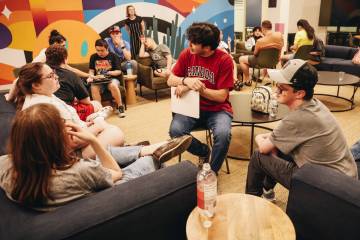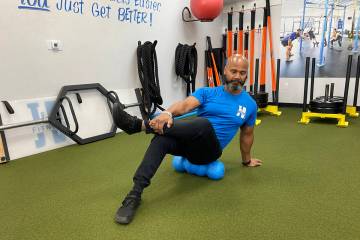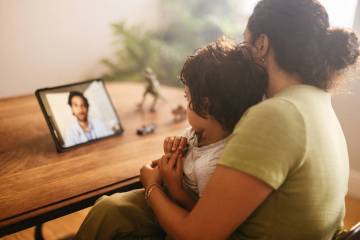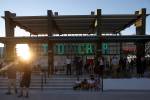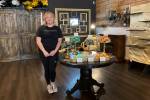Phoenix’s Heard Museum showcases Native American culture
It's a good thing that the handmade Indian jewelry at the Heard Museum is behind glass, because I was in danger of drooling all over it. A gallery, featuring Jesse Monongye's jewelry, showcases turquoise, coral and other precious gems inlaid into silver and gold. From necklaces to bolo ties, the collection is stunning.
Phoenix's Heard Museum is one of the premier museums in the country. Featuring artifacts and contemporary work of Native Americans of the Southwest, it attracts more than 200,000 visitors a year, with 70 percent of them from outside Arizona.
Covering 130,000 square feet, the Heard contains one of the most comprehensive collections dedicated to the Indians of the Southwest. The four permanent galleries and seven regularly changing galleries feature more than 32,000 artifacts, along with displays of contemporary art, weaving and history. (A second, smaller museum, the Heard Museum North Scottsdale, in the Phoenix suburb , houses additional exhibits .)
The Phoenix museum is well-known for its high-quality artwork, not only in the galleries, but among the items for sale in the gift shop. The Museum Shop guarantees that there are no reproductions or imitations among its fine jewelry, pottery, paintings, sculptures and weavings. Bruce McGee, vice president of retail sales, is a third-generation Indian art trader and an expert on the subject.
The Heard Museum was founded by two Phoenix residents, Dwight and Maie Heard. Dwight Bancroft Heard married the boss's daughter, Maie Bartlett, in Chicago while he was working for the company that was the precursor of True Value hardware stores. Just one year after the wedding, Dwight was diagnosed with lung problems, and the doctor recommended the young couple move to a warmer climate. In 1895, Phoenix was chosen as the best location.
The Heards became one of the largest landowners in the Salt River Valley, and the Bartlett-Heard Land and Cattle Co. south of Phoenix raised everything from prize cattle to cotton. Dwight was president of the Arizona Cotton Growers' Association. They were both active in civic affairs, and Maie and other Bartlett family members donated the land for the Phoenix Art Museum.
Dwight developed a neighborhood called Los Olivos and planted palm trees along its four miles of roads. It is believed the Heards introduced the beautiful trees to Phoenix. In the middle of Los Olivos, the Heards built a 6,000-square-foot home called the "Casa Blanca."
Over the years, the house filled with the Heards' vast collection of Native American artifacts, and at the suggestion of their daughter-in-law, they built the Heard Museum next to their home. Dwight died of a heart attack several months before the museum opened in June 1929. The museum has grown, incorporating Casa Blanca and its courtyards, plus several large additions. Maie remained active in the museum until her death in 1951.
My husband, Richard, and I started our visit with "Highlights of the Heard," one of several tours offered daily. This enabled us to see the best of each gallery and learn the history of the museum.
The "We Are! Arizona's First People" gallery features displays from each of Arizona's 21 tribal communities. Tribal members designed the displays and chose items they felt portrayed their tribe. There are galleries featuring Navajo rugs and ones with hands-on displays for children.
I found the "Remembering Our Indian School Days: The Boarding School Experience" to be a very touching display. From 1870-1920, the government tried to solve what it perceived as the "Indian problem" by forcibly taking the children and putting them in boarding schools. They weren't allowed to speak their native language and were forced to cut their hair. Reading, writing and some arithmetic were taught along with the skills needed for students to become domestic servants and manual laborers. Many of the children didn't go home for almost 10 years. When they got home, they couldn't understand their parents and didn't fit in with the tribal culture.
We ate lunch at the museum's cafe. There is inside seating or you can be served in the courtyard. They offer unusual dishes, such as the Chicken Tinga, which I ordered. Richard had a roasted pear salad that looked delicious. I tried to steal a bite, but he protected it with a sharp fork.
With a full stomach, it was back to exploring the Heard. There is a full-size hogan, the traditional home of the Navajo people. On an inside wall is a framed sand painting. I stared at it until I was convinced it is a copy of a sand painting, and then a docent told me it is an actual sand painting that has been framed. Sand paintings are intricate pictures formed from different-colored sands and are used during special Navajo ceremonials.
Since I love archaeology, the "Home: Native People in the Southwest" exhibit appealed to me. It contains many of the old baskets, pottery and traditional dress. The Ancestral Puebloan (Anasazi) display of 500- to 2,300-year-old pots, baskets and other artifacts was my favorite.
I was stunned by the Barry Goldwater collection of katsina dolls. Goldwater donated his personal collection of more than 400 of these Hopi figures to the Heard. Made from cottonwood root, these carvings represent Hopi spirit beings.
After poking my head into all the nooks and crannies of the Heard, I headed for the Museum Shop. I must have incredibly good taste, because I was naturally drawn to the most expensive items. Richard worriedly offered to hold my credit cards, but I assured him I would control my spending. I especially liked one belt made of inlaid stones, but it was $10,000. I reluctantly started looking through the nice book collection. The quirky Navajo Folk Art with colorful chickens and laughing horses was more in my price range. I took one last look at that exquisite Indian jewelry, wiped the drool off my lower lip and headed home.





